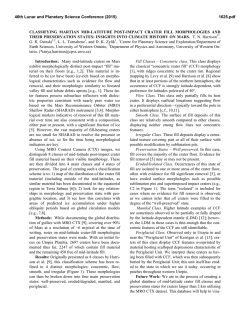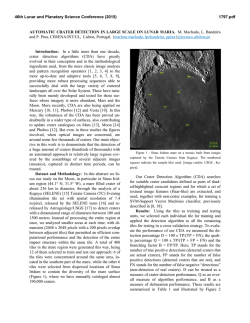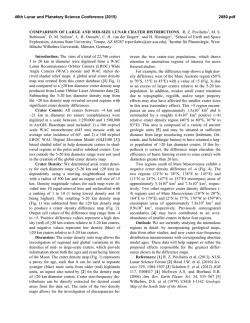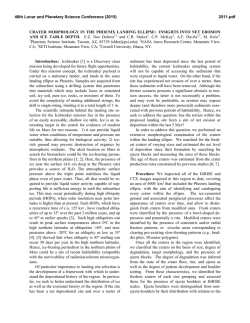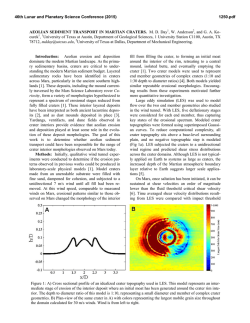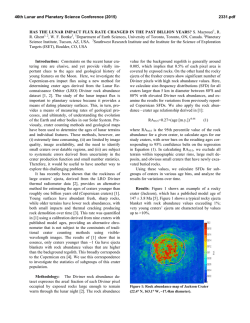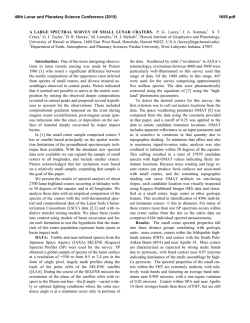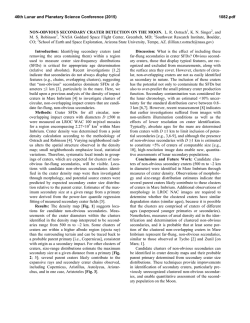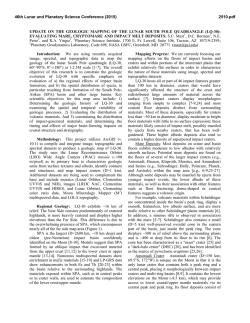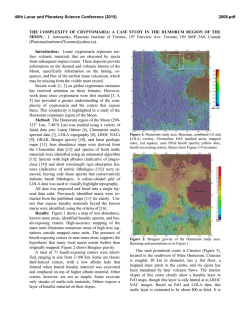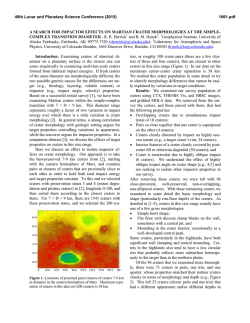
Contribution of Secondary Craters on the Icy - USRA
46th Lunar and Planetary Science Conference (2015) 2530.pdf CONTRIBUTION OF SECONDARY CRATERS ON THE ICY SATELLITES: RESULTS FROM GANYMEDE AND RHEA. T. Hoogenboom1, K. E. Johnson2 and P. M. Schenk1, 1Lunar and Planetary Institute (3600 Bay Area Blvd., Houston TX 77058) and [email protected]), 2Rice University (6100 Main St., Houston TX 77005). Introduction: At present, surface ages of bodies in the Outer Solar System are determined only from crater size–frequency distributions. This method is dependent on an understanding of the projectile populations responsible for impact craters in these planetary systems. To derive accurate ages using impact craters, the impactor population must be understood, as impact craters in the Outer Solar System can be primary, secondary or sesquinary. The contribution of secondary craters to the overall population has become a “topic of interest.” Recent work has pointed to the potential contribution of secondary cratering to the background population on places like Mars [1,2], although not without controversy [e.g. 3]. Our objective is to better understand the contribution of dispersed secondary craters to the small crater populations, and ultimately that of small comets to the projectile flux on icy satellites. The degree to which secondary craters may or may not contribute to such populations on icy bodies has been partially answered by a detailed study of Europa [4] but pertains only to the smaller craters (<1 km), leaving a gap in our understanding of craters between 1 and 20 km diameters. To this end we investigate secondary crater statistics on the icy satellite Ganymede. Our primary focus has been bright terrain. These resurfaced terrains have relatively low crater densities allowing secondary crater populations to be easily recognized. We also examine large recent primary craters on midsize icy satellites (e.g. Rhea and Dione) for comparison on bodies with low surface gravity. Method: We measure the diameters of obvious secondary craters (determined by e.g. irregular crater shape, small size, clustering) formed by all primary craters on icy moons for which we have sufficiently high-resolution data to map secondary craters. High resolution Galileo data (< 300 m) of Ganymede is severely restricted but several mapping sites occur within the secondary fields of large craters [e.g. Misharu (Fig 1) (d = 90 km), Enkidu (d = 123 km) and Epigeus (d = 207 km)]. At several sites we have constructed topographic maps using shape-from-shading topographic mapping techniques e.g. [5]. Stereogrammetry methods do not have sufficient resolution. Secondary craters are usually shallower than similar sized primaries by 25 to 50% e.g. [1, 6]. Shape-from-shading results may have ambiguities over longer length scales but here we are less concerned with absolute values (although every effort was made to construct accurate maps using the most up-to-date photometric models, etc. and determine if secondary craters on Ganymede have shallow depths similar to those on Mars [e.g. 1] and Europa [e.g. 6]. Our primary goal here is to distinguish shallow secondary craters from deeper primaries in cases where there is some uncertainty in identification. Shape-fromshading techniques have been used successfully on both Europa and Ganymede in investigating primary crater shapes [7, 8]. Figure 1 a,b: Galileo mosaic of Kittu crater located at 0.4N 334.6W. Secondary craters originate from Misharu crater to the South (not shown) and are outlined in red. The blue area represents Kittu ejecta and was excluded from counts. Results: Using Galileo and Voyager data, we have identified approximately 3,400 secondary craters on Ganymede from 11 primary craters. Primary craters studied range from approximately 40 km to 210 km. 46th Lunar and Planetary Science Conference (2015) Figure 3: Cumulative size-frequency distributions of all secondary crater fields counted on Ganymede shown in grey. Secondary crater counts from Rhea (red), Mars (green) and Europa (yellow) are shown for comparison. 1 0.1 R-‐value Image resolutions range from 45 to 440 m/pixel. For some craters (e.g. Enkidu, Gula, Achelous, Zakar and Misharu), we measured secondary crater diameters as a function of distance from the primary crater. Secondary craters measured on Ganymede varied in size from 0.22 km (Enkidu origin) to 13 km (Epigeus origin) – (Figure 2, 3, 4). We have also compiled crater statistics for secondary craters observed on Europa (e.g. 40 km diameter primary crater Tyre [9]), Rhea (e.g. 48 km primary crater Inktomi [Hoogenboom et al] – Figure 3) and other midsize satellites. We compare all of these results to similar studies of secondary cratering on Moon, Mars [9] and Mercury. 2530.pdf 0.01 0.001 Cumula2ve number of craters km-‐2 1.E+07 0.0001 1.E+06 0.1 1 Diameter (km) 10 Figure 4: R-plots of all secondary crater fields counted on Ganymede where red is Misharu, blue is Gula, yellow is Enkidu, green is Enkidu high resolution, black is Zakar, brown is Tashmetum, and grey, orange and pink are three different crater fields originating from Epigeus. 1.E+05 1.E+04 1.E+03 1.E+02 1.E+01 1.E+00 0.1 1 10 Diameter (km) 100 Figure 2: Cumulative size-frequency distributions of all secondary crater fields counted on Ganymede where red is Misharu, blue is Gula, yellow is Enkidu, green is Enkidu high resolution, black is Zakar, brown is Tashmetum, and grey, orange and pink are three different crater fields originating from Epigeus. 1.E+06 1.E+05 1.E+04 Cumula2ve number of craters km-‐2 1.E+07 1.E+03 1.E+02 1.E+01 1.E+00 0.1 1 10 Diameter (km) 100 Conclusions: Our counts of secondary craters, especially on Ganymede, provide a new set of measurements with which to evaluate secondary populations on large icy bodies. Because of the limitations of the Galileo data, it is necessary to extrapolate from limited counting areas to the global population of secondary craters. Nonetheless, we confirm that secondary craters on Ganymede have narrow size–frequency distributions and that they correlate with primary crater diameter. For example, secondaries from Misharu (d = 90 km) range in diameter from 0.53 km to 5.74 km with a mean diameter of 1.27 km. From these data we will evaluate the global contribution of secondary craters over a range of crater diameters. References: [1] McEwen A. et al. (2005) Icarus, 176, 351-381 [2] McEwen A. and Bierhaus B. (2006) Ann. Rev. Earth Planet. Sci., 34, 535-567 [3] Werner S. et al. (2009) Icarus, 200, 406-417 [4] Bierhaus, B. et al. (2005) Nature, 437, 1125-1127 [5] Schenk, P. and Williams D. (2004) Geophys. Res. Lett., L23702 [6] Bierhaus, B. and Schenk P. (2010) Icarus. Icarus, 226, 1, 865-884 [7] Schenk, P. (2002) Nature, 417, 419-421 [8] Schenk, P. et al. (2004) Jupiter, F. Bagenal, T. Dowling, and W. McKinnon, eds., pp. 427-456, Cambridge Univ. Press, Cambridge [9] Singer K. et. al (2013) Icarus 226, 1, 865-884 [10] Hoogenboom T. et. al (2012) LPSC XLII Abstract # 2579 [11] Robbins S.J. and Hynek B.M. (2011) J. Geophys. Res, 116, E10003.
© Copyright 2025

